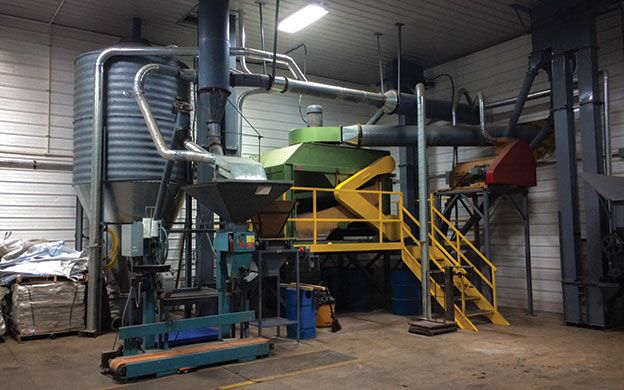In The County, investment equals jobs
The Maine Malt House, part of the family-owned Buck Farms in Mapleton, Aroostook County, was established last year by brothers Joshua, Jacob and Jared Buck to provide malt for the booming craft-beer industry.
None of the three Buck brothers ever wanted to leave home beyond going to college — Joshua in residential construction, Jacob in electrical engineering and Jared in computer-aided drafting — but the farm wasn't big enough for the brothers to establish themselves as owners. So they researched an alternative crop and came upon malt barley as one that would fit with the burgeoning craft beer industry. They drew up a business plan, obtained two agricultural development grants totaling $95,000 to buy a dry kiln and quality-monitoring equipment, and invested sweat equity to cultivate 250 acres, which last year and this yielded 700 tons of grain all told.
“We're at the stage of growing our customer base, getting breweries to try our product and switch some of their malt order to us,” says Joshua Buck.
With barley otherwise sourced from the western United States, Canada and Europe, the Bucks figure they're positioned to capitalize on the growing demand for local product.
“You can't beat being here in The County,” he says. “One of the big things is the people. And it's so beautiful. You wake up and look outside and it's a beautiful day. Plus it's nice to work with your family every day.”
Flight of the youth
Still, the story of the Buck brothers is where The County would like to be headed, but it's not necessarily representative of the past five decades.
Aroostook County, youth flight in relation to a lack of professional employment opportunities and the closure of Loring Air Force Base in the early 1990s has driven the population down by a third from its peak in 1960.
The Aroostook Partnership for Progress seeks to reverse that trend by attracting new employers, retaining existing employers, connecting with educators to link students with emerging jobs and showing folks who have departed, no matter their age, they can get both good jobs and a great quality of life at home.
With the help of APP's advocacy, networking and facilitation efforts, The County has seen more than $500 million in investment, with about 430 new jobs created over the last three years and an increase in average wages of more than $37,000, says APP president Robert Dorsey.
“For a rural county in Maine, that's significant,” he says.
APP's goal is 3,000 new jobs, continued investment and increases in wages. It is targeting four industries: alternative energy, forestry, manufacturing and diversified agriculture.
“We've been looking internally at the county's assets, strengths and opportunities, and basing our growth on that,” Dorsey says.
APP is a public-private partnership that got its start in 2004, in response to a report that documented the population decline between the 1960s and 2001. “Tarnished Crown: Building A Future For The Children of Aroostook County,” prepared by the Northern Maine Development Commission and the Maine Public Service Company with help from economist Charles Colgan, says the county's peak population was 106,064 in 1960. Over the subsequent four decades, the population declined to 73,140 — the largest population drop of any county in New England. Through 2012, the population continued to decline, to 71,757. The 1994 closure of Aroostook's Loring Air Force Base, exacerbated the problem, the report says.
Without mitigation efforts, the report suggests a scenario in which population decline could continue at the same rate to 2025, with a net loss of about 650 people per year.
Aroostook is also challenged by a rise in median age, as baby boomers grow older and younger people leave. All of Maine is similarly challenged. However, the report says, Aroostook's decline is most striking among Maine's counties, with more than 40% of youth age 15 to 29 leaving the county in the 1990s.
The projected population decline and the resulting challenge of securing a future workforce was one driver for forming APP, says Dorsey.
“There's a perception that you have to leave the county or the state to get a good job, which isn't the case,” Dorsey says. “Growing that awareness is important.”
Adam Cyr agrees. He grew up in Caribou, graduated from the University of Southern Maine in 2004, then managed a hotel in Portland for six years, followed by eight months in Providence, R.I. Today, he's general manager at the Presque Isle Hampton Inn, which opened six years ago and created 34 jobs.
“I got the opportunity to come home,” he says. “My family was home. I like this type of lifestyle. There's a lot to be said for the peacefulness, and I'm big into outdoor activities. In Providence, you can't walk out your door and hop on your snowmobile.”
Bringing talent back home is key for preventing communities from becoming ghost towns, says Dorsey.
“All of rural America is facing same thing we are,” says Dorsey. “There's going to be real competition for the best and brightest students. So we feel we've got to get out ahead of that.”
And APP is helping to do that. Aroostook has seen significant industry and infrastructure development in recent years, and more is on the horizon, says Dorsey. These include $39.14 million in investments, in 2012, in both company-driven and APP-supported energy, broadband and rail infrastructure; $77.2 million in investments and 142 jobs created in 2013, related to further infrastructure improvements and business creation and upgrades; $199 million in investments and 271 jobs created in 2014; and for 2015 so far, an estimated $25 million invested and 134-plus jobs created.
Dorsey says APP is tracking potential in the coming year or two for a variety of additional projects.
In 2009, an industry analysis of the renewable energy industry of northern Maine, conducted by ViTAL Economy and APP and NMDC industry executives and professionals, identified renewable energy as a potential high-growth industry, based on the wind and biomass resources in the region. That finding has been borne out, says Dorsey, by new and proposed projects, including Texas-based EDP Renewables North America's proposal to build a $613 million wind farm of 250 megawatts in the unorganized territory. Missouri-based SunEdison's 148-megawatt, $360 million wind project in Oakfield brought nearly 300 construction jobs.
APP is leading a grassroots effort to advance the forest products sector as a “cluster” with strong potential for adding good-paying jobs in The County, driven by new home construction nationwide, says Dorsey.
“The challenge is that, every time you hear a 60-year-old mill is shutting down, the perception is that the forest industry is dying,” Dorsey says. “But that's not the case. Up here, it's growing.” Recent developments include J.D. Irving Ltd.'s state-of-the-art softwood sawmill in Ashland, a $30 million investment that opened in 2014; ReEnergy Holdings resumption of full operations in late 2014 at its biomass-to-electricity facility in Ashland; Quebec-based Maibec Inc.'s purchase in January 2015 of Fraser Timber LLC's lumber mill in Masardis; and cedar shingle-maker Ecoshel's relocation from Georgia and construction of a mill in Ashland.
Manufacturing appears to be steadily growing, with more than 350 new jobs projected over the next few years, Dorsey says. This includes a potential deal by Beijing-based China North Industries Group Corp., or Norinco, to bring rail car manufacturing to the former Loring Air Force Base in Limestone.
“We have high hopes for that,” Dorsey says.
Diversified agriculture is a focus because of the potential of the county's approximately quarter million acres of underutilized land, says Dorsey. Maine, led by Aroostook County, once produced more potatoes than any other state in the nation. Acreage for potato production today is about half what it was, but in recent years, the loss has been partially offset by efforts to diversify into other crops, the largest of which is broccoli, and into grains and organic food production.
“I'm getting calls from folks outside of New England seeking acreage to grow organic produce and grains,” he says. “There's more than just potatoes growing up here.”
To round out their initiatives, APP is bringing educators into the mix. APP's “Education to Industry” initiative promotes job shadowing and internships to show middle, high school and college students there are good jobs available in the region, with the goal of stemming their outward migration. In tandem, colleges are tailoring programs to suit local industry, he says.
“We're trying to attract folks back to The County,” Dorsey says. “A number have come back in the last few years, but oftentimes, the perception is, 'I'll come back when I retire, because there are not many jobs there.' We're trying to dispel that perception.”













Comments